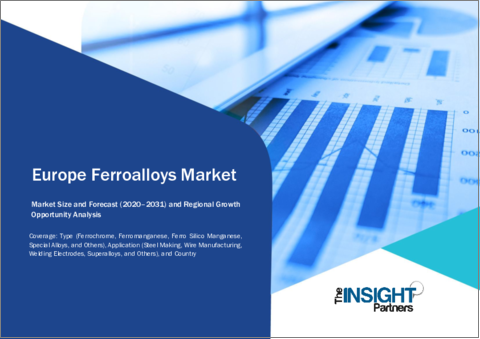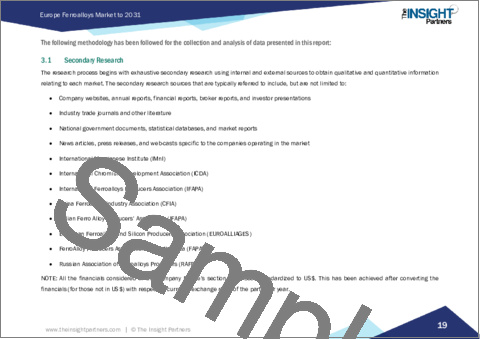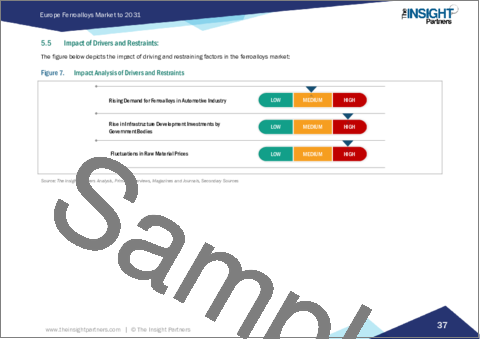|
|
市場調査レポート
商品コード
1597142
欧州の合金鉄市場:2031年までの予測 - 地域別分析 - タイプ別、用途別Europe Ferroalloys Market Forecast to 2031 - Regional Analysis - by Type (Ferrochrome, Ferromanganese, Ferro Silico Manganese, Special Alloys, and Others) and Application (Steel Making, Wire Manufacturing, Welding Electrodes, Superalloys, and Others) |
||||||
|
|||||||
| 欧州の合金鉄市場:2031年までの予測 - 地域別分析 - タイプ別、用途別 |
|
出版日: 2024年10月03日
発行: The Insight Partners
ページ情報: 英文 130 Pages
納期: 即納可能
|
全表示
- 概要
- 図表
- 目次
欧州の合金鉄市場は、2023年に261億3,000万米ドルとなり、2031年までには447億6,000万米ドルに達すると予測され、2023年から2031年までのCAGRは7.0%と推定されます。
政府機関によるインフラ開拓投資の増加が欧州の合金鉄市場を牽引
政府が支援するインフラ・プロジェクトには、道路、ダム、橋、トンネル、港湾、空港舗装、高速道路の建設が含まれます。政府機関からの投資の増加は、インフラ建設の増加につながります。世界銀行機関によると、世界のインフラ投資総額は年間3兆9,000億米ドルに達し、新興国の需要が最も高いです。
これは、2017年から2021年までの平均成長率4%で、2021年と比較して2022年には23%の成長を示しています。2022年、新興諸国ではCOVID-19パンデミック後の投資コミットメントの増大に伴い、建設活動が大幅に回復しています。
2022年、米国運輸省はネット・ゼロ高速道路開発のために3,483万米ドルの資金提供を発表しました。また、ポーランドは現在も交通の発展に多額の資金を投じています。現行のEU資金援助制度の下、政府は2014年から2023年(2025年を視野)の間に、鉄道インフラに175億米ドル、道路インフラに366億米ドルを投資する意向です。さらに、ストックホルムの地下鉄延伸建設プロジェクトは33億5,000万米ドルと評価され、現在建設段階にあり、2026年までに完成する予定です。このプロジェクトは、20kmの新線路と11の新駅の建設で構成されています。
このように、この地域の多くの国々の政府によるインフラ整備への投資と努力の高まりが、合金鉄市場を牽引しています。
欧州の合金鉄市場の概要
この地域は、いくつかの主要な合金鉄生産者と消費者の本拠地であり、合金鉄貿易の不可欠な一部となっています。合金鉄は自動車製造、鉄鋼生産、建設など様々な分野で重要な役割を果たしています。2022年に発表された国際貿易管理局の報告書によると、自動車産業への投資が増加すれば、欧州の自動車部品・材料ビジネスに有利な機会が生まれると思われます。トルコでは、2022年時点で4万8,000台のハイブリッド車と2,000台の電気自動車が道路を走行し、約800カ所の自動車充電ステーションが設置されています。欧州委員会によると、建設産業は欧州の主要産業の1つであり、同地域のGDPに約9%貢献しています。欧州委員会によると、2023年6月、EUは持続可能で安全かつ効率的な交通インフラの建設に60億米ドルを投資し、その中には107の交通インフラプロジェクトが含まれます。欧州建設産業連盟によれば、2022年の欧州における建設投資総額のうち、住宅建設は20.6%を占めました。欧州自動車工業会によると、EUの2023年第1四半期から第3四半期の自動車生産台数は900万台を超え、前年同期比14%増となりました。欧州鋳造協会委員会によると、欧州には6,000以上の金属鋳造施設があり、その70%は中小企業です。鉄鋼製造は、フェロマンガン、フェロシリコン、フェロクロムを含む合金鉄の大幅な消費者です。これらの合金は、鉄鋼に強度、硬度、耐食性などの望ましい特性を付与するもので、インフラや機械製造に使用される高品質の鉄鋼製品を生産するために不可欠です。そのため、欧州の鉄鋼、建設、自動車産業の発展が合金鉄の需要を牽引しています。
欧州の合金鉄市場の収益と2031年までの予測(10億米ドル)
欧州の合金鉄市場のセグメンテーション
欧州の合金鉄市場は、タイプ、用途、国に分類されます。
タイプ別では、欧州の合金鉄市場はフェロクロム、フェロマンガン、フェロシリコマンガン、特殊合金、その他に区分されます。2023年にはフェロシリコマンガンセグメントが最大の市場シェアを占めています。
用途別では、欧州の合金鉄市場は製鋼、ワイヤ製造、溶接電極、超合金、その他に分類されます。2023年には製鋼セグメントが最大の市場シェアを占めました。
国別では、欧州の合金鉄市場はドイツ、フランス、イタリア、英国、ロシア、その他欧州に区分されます。ロシアが2023年の欧州の合金鉄市場シェアを独占しました。
Glencore Plc、Ferro Alloys Corp Ltd、Brahm Group、Tata Steel Ltd、Nikopol Ferroalloys Plantは、欧州の合金鉄市場で事業を展開している主要企業です。
目次
第1章 イントロダクション
第2章 エグゼクティブサマリー
- 主要洞察
- 市場の魅力
第3章 調査手法
- 2次調査
- 1次調査
- 仮説の策定
- マクロ経済要因分析
- 基礎数値の作成
- データの三角測量
- 国レベルのデータ
第4章 欧州の合金鉄市場情勢
- ポーターズ分析
- 供給企業の交渉力
- 買い手の交渉力
- 新規参入業者の脅威
- 競争企業間の敵対関係
- 代替品の脅威
- エコシステム分析
- 原材料サプライヤー
- 合金鉄メーカー
- ディストリビューター / サプライヤー
- 最終用途産業
第5章 欧州の合金鉄市場:主要市場力学
- 市場促進要因
- 自動車産業における合金鉄需要の増加
- 政府機関によるインフラ整備投資の増加
- 市場抑制要因
- 原材料価格の変動
- 市場機会
- 世界の航空宇宙・防衛産業の成長
- 今後の動向
- 超合金の採用拡大
- 促進要因と抑制要因の影響
第6章 欧州の合金鉄市場分析
- 欧州の合金鉄市場概要
- 合金鉄市場の数量(千トン)、2020年~2031年
- 合金鉄市場の数量予測・分析(千トン)
- 合金鉄市場の収益、2020年~2031年
- 合金鉄市場の予測・分析
第7章 欧州の合金鉄市場規模・収益分析:タイプ別
- フェロクロム
- フェロマンガン
- フェロシリコマンガン
- 特殊合金
- その他
第8章 欧州の合金鉄市場収益分析:用途別
- 製鋼
- ワイヤー製造
- 溶接電極
- 超合金
- その他
第9章 欧州の合金鉄市場:国別分析
- 欧州市場概要
- ドイツ
- フランス
- イタリア
- 英国
- ロシア
- その他欧州
第10章 競合情勢
- ヒートマップ分析:主要企業別
- 企業のポジショニングと集中度
第11章 業界情勢
- 合併と買収
- 事業拡大
- パートナーシップと提携
第12章 企業プロファイル
- Glencore Plc
- Ferro Alloys Corporation Limited(FACOR)
- Brahm Group
- Tata Steel Ltd
- Nikopol Ferroalloy Plant
第13章 付録
List Of Tables
- Table 1. Europe Ferroalloys Market Segmentation
- Table 2. Ferroalloys Market - Volume and Forecast to 2031 (Thousand Tons)
- Table 3. Ferroalloys Market - Revenue and Forecast to 2031 (US$ Billion)
- Table 4. Ferroalloys Market - Volume and Forecast to 2031 (Thousand Tons) - by Type
- Table 5. Ferroalloys Market - Revenue and Forecast to 2031 (US$ Billion) - by Type
- Table 6. Ferroalloys Market - Revenue and Forecast to 2031 (US$ Billion) - by Application
- Table 7. Europe Ferroalloys Market - Volume and Forecast to 2031 (Thousand Tons) - by Country
- Table 8. Europe Ferroalloys Market - Revenue and Forecast to 2031 (US$ Billion) - by Country
- Table 9. Germany Ferroalloys Market -Volume and Forecast to 2031 (Thousand Tons) - by Type
- Table 10. Germany Ferroalloys Market - Revenue and Forecast to 2031 (US$ Billion) - by Type
- Table 11. Germany Ferroalloys Market - Revenue and Forecast to 2031 (US$ Billion) - by Application
- Table 12. France Ferroalloys Market -Volume and Forecast to 2031 (Thousand Tons) - by Type
- Table 13. France Ferroalloys Market - Revenue and Forecast to 2031 (US$ Billion) - by Type
- Table 14. France Ferroalloys Market - Revenue and Forecast to 2031 (US$ Billion) - by Application
- Table 15. Italy Ferroalloys Market -Volume and Forecast to 2031 (Thousand Tons) - by Type
- Table 16. Italy Ferroalloys Market - Revenue and Forecast to 2031 (US$ Billion) - by Type
- Table 17. Italy Ferroalloys Market - Revenue and Forecast to 2031 (US$ Billion) - by Application
- Table 18. United Kingdom Ferroalloys Market -Volume and Forecast to 2031 (Thousand Tons) - by Type
- Table 19. United Kingdom Ferroalloys Market - Revenue and Forecast to 2031 (US$ Billion) - by Type
- Table 20. United Kingdom Ferroalloys Market - Revenue and Forecast to 2031 (US$ Billion) - by Application
- Table 21. Russia Ferroalloys Market -Volume and Forecast to 2031 (Thousand Tons) - by Type
- Table 22. Russia Ferroalloys Market - Revenue and Forecast to 2031 (US$ Billion) - by Type
- Table 23. Russia Ferroalloys Market - Revenue and Forecast to 2031 (US$ Billion) - by Application
- Table 24. Rest of Europe Ferroalloys Market -Volume and Forecast to 2031 (Thousand Tons) - by Type
- Table 25. Rest of Europe Ferroalloys Market - Revenue and Forecast to 2031 (US$ Billion) - by Type
- Table 26. Rest of Europe Ferroalloys Market - Revenue and Forecast to 2031 (US$ Billion) - by Application
List Of Figures
- Figure 1. Europe Ferroalloys Market Segmentation, by Country
- Figure 2. Ferroalloys Market Porter's Analysis
- Figure 3. Ecosystem: Ferroalloys Market
- Figure 4. Ferroalloys Market - Key Market Dynamics
- Figure 5. Global Electric Car Sales (2016-2023)
- Figure 6. Fluctuations in Iron Ore Prices from January 2019 to April 2023
- Figure 7. Impact Analysis of Drivers and Restraints
- Figure 8. Ferroalloys Market Volume (Thousand Tons), 2020-2031
- Figure 9. Ferroalloys Market Revenue (US$ Billion), 2020-2031
- Figure 10. Ferroalloys Market Share (%) - Type, 2023 and 2031
- Figure 11. Ferrochrome: Ferroalloys Market - Volume and Forecast to 2031 (Thousand Tons)
- Figure 12. Ferrochrome: Ferroalloys Market - Revenue and Forecast to 2031 (US$ Billion)
- Figure 13. Ferromanganese: Ferroalloys Market - Volume and Forecast to 2031 (Thousand Tons)
- Figure 14. Ferromanganese: Ferroalloys Market - Revenue and Forecast to 2031 (US$ Billion)
- Figure 15. Ferro Silico Manganese: Ferroalloys Market - Volume and Forecast to 2031 (Thousand Tons)
- Figure 16. Ferro Silico Manganese: Ferroalloys Market - Revenue and Forecast to 2031 (US$ Billion)
- Figure 17. Special Alloys: Ferroalloys Market - Volume and Forecast to 2031 (Thousand Tons)
- Figure 18. Special Alloys: Ferroalloys Market - Revenue and Forecast to 2031 (US$ Billion)
- Figure 19. Others: Ferroalloys Market - Volume and Forecast to 2031 (Thousand Tons)
- Figure 20. Others: Ferroalloys Market - Revenue and Forecast to 2031 (US$ Billion)
- Figure 21. Ferroalloys Market Share (%) - Application, 2023 and 2031
- Figure 22. Steel Making: Ferroalloys Market - Revenue and Forecast to 2031 (US$ Billion)
- Figure 23. Wire Manufacturing: Ferroalloys Market - Revenue and Forecast to 2031 (US$ Billion)
- Figure 24. Welding Electrodes: Ferroalloys Market - Revenue and Forecast to 2031 (US$ Billion)
- Figure 25. Superalloys: Ferroalloys Market - Revenue and Forecast to 2031 (US$ Billion)
- Figure 26. Others: Ferroalloys Market - Revenue and Forecast to 2031 (US$ Billion)
- Figure 27. Europe Ferroalloys Market, by Key Country - Revenue (2023) (US$ Billion)
- Figure 28. Europe Ferroalloys Market Breakdown, by Key Countries, 2023 and 2031 (%)
- Figure 29. Germany Ferroalloys Market - Revenue and Forecast to 2031 (US$ Billion)
- Figure 30. France Ferroalloys Market - Revenue and Forecast to 2031 (US$ Billion)
- Figure 31. Italy Ferroalloys Market - Revenue and Forecast to 2031 (US$ Billion)
- Figure 32. United Kingdom Ferroalloys Market - Revenue and Forecast to 2031 (US$ Billion)
- Figure 33. Russia Ferroalloys Market - Revenue and Forecast to 2031 (US$ Billion)
- Figure 34. Rest of Europe Ferroalloys Market - Revenue and Forecast to 2031 (US$ Billion)
- Figure 35. Heat Map Analysis by Key Players
- Figure 36. Company Positioning & Concentration
The Europe ferroalloys market was valued at US$ 26.13 billion in 2023 and is expected to reach US$ 44.76 billion by 2031; it is estimated to register a CAGR of 7.0% from 2023 to 2031.
Rise in Infrastructure Development Investments by Government Bodies Drive Europe Ferroalloys Market
Government-supported infrastructure projects involve building roads, dams, bridges, tunnels, ports, airport pavements, and highways. The growing investments from government organizations lead to a rise in infrastructure construction. According to the World Bank Organization, the total global infrastructure investment reached US$ 3.9 trillion annually, with the highest demands in emerging countries.
This represents 23% growth in 2022 compared to 2021, at an average growth rate of 4% during 2017-2021. In 2022, there has been a significant rebound in construction activities in developing countries with growing investment commitments post-COVID-19 pandemic.
In 2022, the Department for Transport of the UK announced the funding of US$ 34.83 million to develop net zero highways. Also, Poland is still investing a sizable amount of money in the advancement of transportation. Under the present EU funding system, the government intends to invest US$ 17.5 billion in railway infrastructure and US$ 36.6 billion in road infrastructure between 2014 and 2023 (with a view to 2025). Additionally, the construction project at the Stockholm metro extension is valued at US$ 3.35 billion, which is currently in construction phase and is expected to be completed by 2026. The project comprises the construction of a new track of 20 km and 11 new train stations.
Thus, the rising investments and efforts in infrastructure development by governments of numerous countries across the region drive the ferroalloys market.
Europe Ferroalloys Market Overview
The region is home to several major ferroalloy producers as well as consumers, making it an integral part of the ferroalloy trade. Ferroalloys play a crucial role in various sectors, such as automotive manufacturing, steel production, and construction. According to the International Trade Administration report published in 2022, increased investments in the automotive industry would create lucrative opportunities for businesses of automotive components and materials in Europe. Turkey marked the presence of 48,000 hybrid and 2,000 electric vehicles on the roads and ~800 vehicle charging stations as of 2022. According to the European Commission, the construction industry is one of the major industries in Europe, contributing ~9% to the region's GDP. As per the European Commission, in June 2023, the EU invested ~US$ 6 billion in the construction of sustainable, safe, and efficient transport infrastructure, including 107 transport infrastructure projects. As per the European Construction Industry Federation, residential construction accounted for 20.6% of the total construction investments in Europe in 2022. According to the European Automobile Manufacturers' Association, the EU registered the production of more than 9 million cars in the first three quarters of 2023, a rise of 14% from the same quarter in 2022. According to the Committee of Associations of European Foundries-the European Foundry Association-Europe has more than 6,000 metal casting facilities, of which 70% of companies are small businesses. Steel manufacturing is a substantial consumer of ferroalloys, which include ferromanganese, ferrosilicon, and ferrochrome. These alloys impart desirable properties to steel, such as strength, hardness, and corrosion resistance, making them essential for producing high-quality steel products used in infrastructure and machinery production. Therefore, developments in the steel, construction, and automotive industries in Europe drive the demand for ferroalloys.
Europe Ferroalloys Market Revenue and Forecast to 2031 (US$ Billion)
Europe Ferroalloys Market Segmentation
The Europe ferroalloys market is categorized into type, application, and country.
Based on type, the Europe ferroalloys market is segmented into ferrochrome, ferromanganese, ferro silico manganese, special alloys, and others. The ferro silico manganese segment held the largest market share in 2023.
In terms of application, the Europe ferroalloys market is categorized into steel making, wire manufacturing, welding electrodes, superalloys, and others. The steel making segment held the largest market share in 2023.
By country, the Europe ferroalloys market is segmented into Germany, France, Italy, the UK, Russia, and the Rest of Europe. Russia dominated the Europe ferroalloys market share in 2023.
Glencore Plc, Ferro Alloys Corp Ltd, Brahm Group, Tata Steel Ltd, and Nikopol Ferroalloys Plant, are some of the leading companies operating in the Europe ferroalloys market.
Table Of Contents
1. Introduction
- 1.1 The Insight Partners Research Report Guidance
- 1.2 Market Segmentation
2. Executive Summary
- 2.1 Key Insights
- 2.2 Market Attractiveness
3. Research Methodology
- 3.1 Secondary Research
- 3.2 Primary Research
- 3.2.1 Hypothesis formulation:
- 3.2.2 Macro-economic factor analysis:
- 3.2.3 Developing base number:
- 3.2.4 Data Triangulation:
- 3.2.5 Country level data:
4. Europe Ferroalloys Market Landscape
- 4.1 Overview
- 4.2 Porters Analysis
- 4.2.1 Bargaining Power of Suppliers
- 4.2.2 Bargaining Power of Buyers
- 4.2.3 Threat of New Entrants
- 4.2.4 Intensity of Competitive Rivalry
- 4.2.5 Threat of Substitutes
- 4.3 Ecosystem Analysis
- 4.3.1 Raw Material Suppliers
- 4.3.2 Ferroalloys Manufacturers
- 4.3.3 Distributors/Suppliers
- 4.3.4 End-Use Industry
5. Europe Ferroalloys Market - Key Market Dynamics
- 5.1 Market Drivers
- 5.1.1 Rising Demand for Ferroalloys in Automotive Industry
- 5.1.2 Rise in Infrastructure Development Investments by Government Bodies
- 5.2 Market Restraints
- 5.2.1 Fluctuations in Raw Material Prices
- 5.3 Market Opportunities
- 5.3.1 Growth in Global Aerospace & Defense Industry
- 5.4 Future Trends
- 5.4.1 Growing Adoption of Superalloys
- 5.5 Impact of Drivers and Restraints:
6. Ferroalloys Market - Europe Analysis
- 6.1 Europe Ferroalloys Market Overview
- 6.2 Ferroalloys Market Volume (Thousand Tons), 2020-2031
- 6.3 Ferroalloys Market Volume Forecast and Analysis (Thousand Tons)
- 6.4 Ferroalloys Market Revenue (US$ Billion), 2020-2031
- 6.5 Ferroalloys Market Forecast and Analysis
7. Europe Ferroalloys Market Volume and Revenue Analysis - by Type
- 7.1 Ferrochrome
- 7.1.1 Overview
- 7.1.2 Ferrochrome: Ferroalloys Market - Volume and Forecast to 2031 (Thousand Tons)
- 7.1.3 Ferrochrome: Ferroalloys Market - Revenue and Forecast to 2031 (US$ Billion)
- 7.2 Ferromanganese
- 7.2.1 Overview
- 7.2.2 Ferromanganese: Ferroalloys Market - Volume and Forecast to 2031 (Thousand Tons)
- 7.2.3 Ferromanganese: Ferroalloys Market - Revenue and Forecast to 2031 (US$ Billion)
- 7.3 Ferro Silico Manganese
- 7.3.1 Overview
- 7.3.2 Ferro Silico Manganese: Ferroalloys Market - Volume and Forecast to 2031 (Thousand Tons)
- 7.3.3 Ferro Silico Manganese: Ferroalloys Market - Revenue and Forecast to 2031 (US$ Billion)
- 7.4 Special Alloys
- 7.4.1 Overview
- 7.4.2 Special Alloys: Ferroalloys Market - Volume and Forecast to 2031 (Thousand Tons)
- 7.4.3 Special Alloys: Ferroalloys Market - Revenue and Forecast to 2031 (US$ Billion)
- 7.5 Others
- 7.5.1 Overview
- 7.5.2 Others: Ferroalloys Market - Volume and Forecast to 2031 (Thousand Tons)
- 7.5.3 Others: Ferroalloys Market - Revenue and Forecast to 2031 (US$ Billion)
8. Europe Ferroalloys Market Revenue Analysis - by Application
- 8.1 Steel Making
- 8.1.1 Overview
- 8.1.2 Steel Making: Ferroalloys Market - Revenue and Forecast to 2031 (US$ Billion)
- 8.2 Wire Manufacturing
- 8.2.1 Overview
- 8.2.2 Wire Manufacturing: Ferroalloys Market - Revenue and Forecast to 2031 (US$ Billion)
- 8.3 Welding Electrodes
- 8.3.1 Overview
- 8.3.2 Welding Electrodes: Ferroalloys Market - Revenue and Forecast to 2031 (US$ Billion)
- 8.4 Superalloys
- 8.4.1 Overview
- 8.4.2 Superalloys: Ferroalloys Market - Revenue and Forecast to 2031 (US$ Billion)
- 8.5 Others
- 8.5.1 Overview
- 8.5.2 Others: Ferroalloys Market - Revenue and Forecast to 2031 (US$ Billion)
9. Europe Ferroalloys Market - Country Analysis
- 9.1 Europe Market Overview
- 9.1.1 Europe Ferroalloys Market Breakdown, by Key Country, 2023 and 2031 (%)
- 9.1.1.1 Europe Ferroalloys Market Volume and Forecast and Analysis - by Country
- 9.1.1.2 Europe Ferroalloys Market Revenue and Forecast and Analysis -by Country
- 9.1.1.3 Germany Ferroalloys Market - Revenue and Forecast to 2031 (US$ Billion)
- 9.1.1.3.1 Germany Ferroalloys Market Breakdown by Type
- 9.1.1.3.2 Germany Ferroalloys Market Breakdown by Application
- 9.1.1.4 France Ferroalloys Market - Revenue and Forecast to 2031 (US$ Billion)
- 9.1.1.4.1 France Ferroalloys Market Breakdown by Type
- 9.1.1.4.2 France Ferroalloys Market Breakdown by Application
- 9.1.1.5 Italy Ferroalloys Market - Revenue and Forecast to 2031 (US$ Billion)
- 9.1.1.5.1 Italy Ferroalloys Market Breakdown by Type
- 9.1.1.5.2 Italy Ferroalloys Market Breakdown by Application
- 9.1.1.6 United Kingdom Ferroalloys Market - Revenue and Forecast to 2031 (US$ Billion)
- 9.1.1.6.1 United Kingdom Ferroalloys Market Breakdown by Type
- 9.1.1.6.2 United Kingdom Ferroalloys Market Breakdown by Application
- 9.1.1.7 Russia Ferroalloys Market - Revenue and Forecast to 2031 (US$ Billion)
- 9.1.1.7.1 Russia Ferroalloys Market Breakdown by Type
- 9.1.1.7.2 Russia Ferroalloys Market Breakdown by Application
- 9.1.1.8 Rest of Europe Ferroalloys Market - Revenue and Forecast to 2031 (US$ Billion)
- 9.1.1.8.1 Rest of Europe Ferroalloys Market Breakdown by Type
- 9.1.1.8.2 Rest of Europe Ferroalloys Market Breakdown by Application
- 9.1.1 Europe Ferroalloys Market Breakdown, by Key Country, 2023 and 2031 (%)
10. Competitive Landscape
- 10.1 Heat Map Analysis by Key Players
- 10.2 Company Positioning & Concentration
11. Industry Landscape
- 11.1 Overview
- 11.2 Mergers and Acquisitions
- 11.3 Expansion
- 11.4 Partnerships and Collaborations
12. Company Profiles
- 12.1 Glencore Plc
- 12.1.1 Key Facts
- 12.1.2 Business Description
- 12.1.3 Products and Services
- 12.1.4 Financial Overview
- 12.1.5 SWOT Analysis
- 12.1.6 Key Developments
- 12.2 Ferro Alloys Corporation Limited (FACOR)
- 12.2.1 Key Facts
- 12.2.2 Business Description
- 12.2.3 Products and Services
- 12.2.4 Financial Overview
- 12.2.5 SWOT Analysis
- 12.2.6 Key Developments
- 12.3 Brahm Group
- 12.3.1 Key Facts
- 12.3.2 Business Description
- 12.3.3 Products and Services
- 12.3.4 Financial Overview
- 12.3.5 SWOT Analysis
- 12.3.6 Key Developments
- 12.4 Tata Steel Ltd
- 12.4.1 Key Facts
- 12.4.2 Business Description
- 12.4.3 Products and Services
- 12.4.4 Financial Overview
- 12.4.5 SWOT Analysis
- 12.4.6 Key Developments
- 12.5 Nikopol Ferroalloy Plant
- 12.5.1 Key Facts
- 12.5.2 Business Description
- 12.5.3 Products and Services
- 12.5.4 Financial Overview
- 12.5.5 SWOT Analysis
- 12.5.6 Key Developments
13. Appendix
- 13.1 About The Insight Partners






